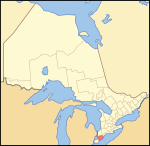Buxton National Historic Site and Museum

The Buxton National Historic Site and Museum is a tribute to the Elgin Settlement (also known as the Buxton Mission, Raleigh, Kent County), established in 1849 by Reverend William King (1812–1895),: 40 and an association which included Lord Elgin, then the Governor General of Canada. King, a former slave owner turned abolitionist, purchased 9,000 acres (36 km2) of crown land in Southwestern Ontario and created a haven for fugitive slaves and free Blacks.: 41 King brought fifteen of his former slaves with him,: 11 where they could live a free life. The Elgin settlement was divided into 50-acre (200,000 m2) lots, intended with one house on each farm lot.: 40 These sold for $2.50/acre, with six percent interest, and could be paid over the course of ten years. By 1864, there was a steam grist mill, steam saw-mill, shoe shop, two general stores, a blacksmith, cooperage, school with forty students on average, and a church (24 by 32 feet (7.3 m × 9.8 m)) seating 200.: 40 For many fugitive slaves, the Buxton settlement was the final stop on the Underground Railroad from the United States – of the twenty-five terminal stations in Canada, seven were in the counties of Kent or Essex.: 11 The need for the mission was considered no longer and the Buxton Mission Fund was closed by 1865 when 'the liberty of the slaves was proclaimed' at the end of the American Civil War.: 42–43 Opened in 1967, the museum complex includes the main building with exhibits about the community and its history, an 1861 schoolhouse, an 1854 log cabin, and a barn. Local historic church cemeteries are adjacent to the museum. The museum is located in North Buxton, Ontario, near South Buxton in Chatham-Kent.
Excerpt from the Wikipedia article Buxton National Historic Site and Museum (License: CC BY-SA 3.0, Authors, Images).Buxton National Historic Site and Museum
Ad Shadd Road,
Geographical coordinates (GPS) Address Website External links Nearby Places Show on map
Geographical coordinates (GPS)
| Latitude | Longitude |
|---|---|
| N 42.305666666667 ° | E -82.220416666667 ° |
Address
Buxton Historic Site & Museum
Ad Shadd Road 21975
N0P 1Y0
Ontario, Canada
Open on Google Maps






